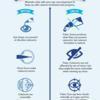What is Traumatic Cataract?

Perhaps the most poorly recognized key health challenge today is trauma. In the developed world, trauma causes monocular blindness. Ocular injury otiology may vary from one urban area to another and therefore needs careful investigation. Any approach for preventing trauma requires familiarity with the cause of its injury. This allows for better targeting of resources to prevent such injuries. The victims of eye trauma and society both bear a huge and perhaps preventable burden.
An eye injury is directly related to traumatic cataracts. While some appear upon injury, others appear several months or years afterwards.
Ophthalmologists often face numerous surgical and medical challenges related to traumatic cataracts. A careful plan for testing and management can make these cases easier to deal with and provide the best outcome.
Extent of Eye Trauma
Patients of acute ocular trauma have to receive systemic evaluation or testing for other potentially life-threatening injuries. This is especially true for emergency cases. It is conducted by a hospital’s emergency medicine department. People who suffer severe ocular trauma may also suffer traumatic brain injury or intracranial bleed. Doctors must determine the extent of ocular trauma once they are sure that only the eye is affected.
General Evaluation
To save the sight and lives of patients, a comprehensive evaluation of the eye is critical. Examples of evaluation approaches are sedation, analgesia, and protection of the injured part from further injury. Additionally, staff counseling is critical for ocular trauma care in the Code Black announcement. If a patient needs other treatments, examination by a team of doctors is important.
Diagnosis
Doctors need to conduct a comprehensive anterior and posterior segment evaluation. Procedures here include:
Imaging
- USG: An investigation into intraorbital and intraocular damage. It sheds light on IOFB, retinal detachment, vitreous hemorrhage and scleral rupture. It may also inform doctors of vitreous exudates which indicate endophthalmitis and posterior lens capsule detachment or rupture. USG may also be used to detect damage to RD, IOFB, extra orbital muscle, and the existence of any foreign body.
- Plain X-ray: Plain X-ray tests are used to examine the injured eye and its orbit to evaluate introcular and extraocular injuries. X-rays may also detect fractures, FB, and foreign bodies.
- CT scan- This is available at almost any hospital. When applied with 1.5-2.0 mm of axial and coronal plains, it is more effective than ultrasound in detecting foreign bodies. As it does not come close to the eye, it is a non-invasive method. It may reveal a deformed eye wall, damage to the eye, retinal detachment, and vitreous hemorrhage.
- MRI: This scan is useful in cases of patients in whom the foreign body is non-magnetic. In cases where the foreign body is magnetic, or when the patient is pregnant, MRI scans can be used, but cautiously. However, doctors cannot use MRI on patients with implanted metallic hardware such as pacemakers. Ophthalmologists are better than radiologists in studying a case through MRI equipment. The fact that this equipment is costlier and less available makes this option is less common.
Electrophysiology
- ERG: This method reviews the vitality of photo receptor functions. It is essential for evaluating eyes without perception.
- MF ERG: This is useful for detecting the affected areas of the retina.
Surgical Management
Peribulbar anesthesia should be administered during surgery for adults. Otherwise, general anesthesia is ideal for uncooperative cases, open-globe injuries, and pediatrics.
Conclusion
If there is clear damage in the lens and cortical material of the eye’s anterior chamber, there may be increased severe inflammatory reaction and IOP. Here, doctors should consider lens removal as well as repair of the eye’s corneal lacerations. Severe cases of corneal trauma and huge edema should be managed with secondary lens removal.















